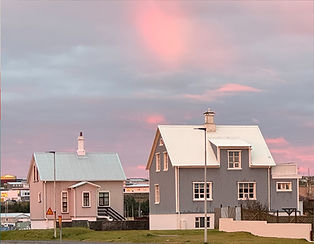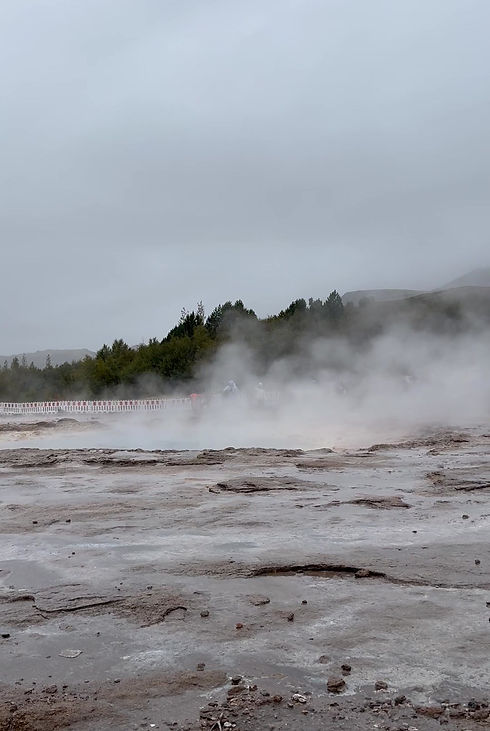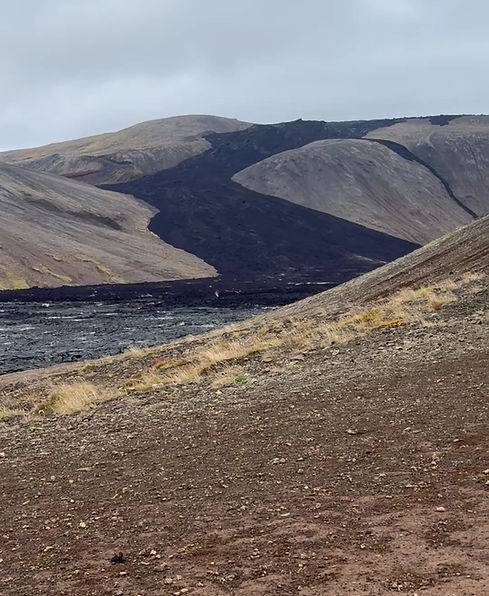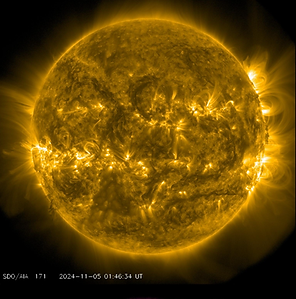
Iceland
The first thing you need to know about Iceland is that it is not covered in ice, as is Greenland, but it is COLD, and it rains often in the “warm” months! The next thing you need to know is that it is way more scenic than you were led to believe. Perhaps most importantly, this is not a budget destination - because it is an island at the arctic circle, almost everything is imported and therefore quite expensive - be prepared to spend some money.




Background
Iceland (pronounced Eeslant in Icelandic) is an island the size of Virginia in the United States or Hungary in Europe. Snuggled up against the arctic circle, it has super long days in summer and almost no daytime in the winter. As a landmass, this island is only about 18 million years old, the bat of an eye in geologic time. It exists as the happy coincidence of a geologic “hotspot” that sits right atop the spreading line of the mid-Atlantic ridge, the joint between which the European and North Atlantic tectonic plates are moving away from each other causing magma to well up in the gap. Because it is extremely geologically active, visitors have the pleasure of experiencing what happens when the inside of the earth spills up onto the outside.
How to book:
-
This is a modern first world country, very connected to the internet. You can easily do the research to find the places you want to go, and book all of your travel online.
Find the right time of year to visit - at the arctic circle the length of daylight hours changes rapidly as the seasons cycle:
-
In winter there is almost no daylight and the cold is accompanied with winter weather conditions. Most roads will be covered with snow or ice. If you like dark and cold conditions, this is for you. It is the best time to see the aurora (northern lights).
-
In the spring, as the days lengthen, the days are warmer and longer and snow will melt away but the more remote places will still be snowbound.
-
The summer is the warmest time of year and the daylight is very long around the summer solstice, and therefore probably the most crowded with tourists.
-
Early fall, around the autumnal equinox is the time when the land is most exposed from the summer warmth melting annual snow, and very green at the end of the growing season. The days and nights are equal in length so there is time for daylight activities and opportunities to see the aurora.
Learn a little Icelandic pronunciation:
-
Most people speak English but it is fun to hear Icelandic spoken and to try it out yourself. I used Lonely Planet Fast Talk Icelandic (from Barnes and Noble)
-
The tourist industry is populated by imported labor, so you will encounter people from many foreign places in the B&Bs and eateries.
Get out into the countryside:
-
Reykjavik has a lot of fun and interesting amenities, like must-see museums, restaurants, bars, shops, and scenic spots, but there is spectacular scenery and natural wonders all over the island and you don’t want to miss a typical Icelandic photo op.
Dress in layers:
-
You will experience warm, sunny weather and cold, windy, wet weather, maybe in the same day! Required garb includes protection for the hands (mittens) and ears (warm hat or ear band). Rain gear is also essential. Don't bother with the umbrella as rain is often accompanied by wind. I wore at least three layers every day.
You will probably not need to change money:
-
Credit is accepted almost everywhere you want/need to spend money, including the gas stations which are automated.
Rent the right vehicle:
-
There is much beauty out there in the countryside, sometimes along unpaved roads. Unless you are on a tour bus, you will need to rent a car because there is no public transportation. If you have a short time and want to catch the usual tourist destinations, you can get by with a sedan, but be advised that a small car is literally SMALL. If there are more than 2 in your party, your luggage will require a larger vehicle.
-
Not all roads are paved. If you're adventurous you may want to rent a 4 wheel drive.
-
Some rental agencies provide a fob that can get you discounts at certain gas stations.
-
We did see EV chargers, sometimes in the most unlikely, out-of-the-way places, but the coverage may not fit your travel plans. Check out a map of locations (see Apps and Links section).
Know the roads before you go:
-
Iceland’s roads are numbered according to accessibility, and there is good, well-maintained pavement along the popular tourist routes. However, much good scenery and back country experiences, away from the madding crowd, are accessed by unpaved roads that vary in condition. Find the road types mapped and check out daily conditions. See Apps and Links section.
-
Speed limits are serious! There are speed cameras that will track your speed and you WILL get a very expensive ticket. Check google maps for locations and stay within the speed limit.

Recommendations
To help you make decisions about your trip

Features
Iceland has much to offer the explorer. You will find most of these natural wonders along the typical tourist tracks, but venturing into the outback to see things not commonly seen and escape the crowds is worth the effort.
Click the buttons to see descriptions and photos of these outstanding features.
Iceland is covered by several “icecaps” - shields of ice that never melt, but flow due to gravity in the form of glaciers. Walking on a glacier is a cool experience, but potentially dangerous so if you are not familiar with the requirements and gear you can join a tour. There are many to choose from, but be sure to seed yourself in the group so that you get the expertise appropriate for your level of comfort for hiking and walking on ice. Another delightful byproduct of these icy features - clear and cold drinking water right from the glacier to the faucet!

Lagoons
Glaciers melt with warm weather and often form lakes (lagoons) at the mouth of the glacier. The lagoon will contain chunks of glacier that have broken off (calved). The larger the lagoon and closer the edge of the glacier to the water, the larger the chunks (icebergs) will be. You can experience these lagoons on your own or rent a ride on a boat in the largest of these lagoons - Jokulsarlon on the southeast coast.
Ice Caves
Naturally formed tunnels in glaciers and ice blocks due to the flow of melting water, ice caves are otherworldly and most offer stunning colors of blue and white as the light penetrates into them. The time to visit is during the cold months when they are most stable, and it is essential to join a tour or get a guide - never attempt to explore these on your own.
If your itinerary lacks the necessary time to explore an ice cave you can visit the artificial one at the Perlan Museum in Reykjavik (where I took these photos).
Waterfalls
The melt water from ice caps, glaciers, and snow fields in the highlands rushes towards the sea, spilling over ancient lava formations in dramatic waterfalls. This features is called "foss" in Icelandic, and that word will be appended to the end of most waterfalls on the map. You will see these dramatic cascades repeatedly in your travels around the island. Some are quite voluminous, such as the Skogafoss (the waterfall of Skoga) on the south coast. Others are an adorable trickle plummeting down the sheer cliff behind a farmhouse. You can believe that some Icelanders consider such water sources to be their own personal rivulet.
Geothermal
Thermal rivers, mud pots, fumerols, geysers, and hot springs are all geothermal features that result from water leaking down through cracks in the crust and encountering rocks that are heating by proximity to magma. These are fascinating spectacles, especially if you stop to think about the molten rock directly under your feet, but are also potentially dangerous and should be approached with care and always within the limits of official recommendations - read the signage!
Much of Iceland’s habitations are powered and heated by super-hot subterranean water, so this nation is very “green” in the sustainability sense. Make sure to add a visit to a geothermal electricity power plant to your itinerary.




Hot Springs
Although technically a geothermal feature, hot springs deserve their own category. Nuff said about that! There are maps of all the hot spring locations on the island, and they are plentiful (see Apps and Links section). Many are developed and visitors can find amenities such as changing rooms, showers, and even casual dining at these establishments, while others are rough and wild and you will want to bring, at a minimum, your own towel. Regardless of the amenities, it can sometimes be rough going getting from the place where you have disrobed to the nice, hot water - and then back again. The most famous and perhaps the most luxurious is the Blue Lagoon on the Reykjanes peninsula. It is the Michelin of hot springs. You will empty your wallet on a ticket, but plan to spend the entire afternoon soaking in the 100 degree water surrounded by steam.

Lava Flows
The map of geologically active areas in Iceland covers the island itself. Since the landscape was formed by volcanoes, recent and ancient, you needn't go far to find lava flows. The most recent incidents are located on the Rekjanes peninsula, southeast of Reykjavik. Hiking trails bring the viewer up onto ridges which offer a vista of solidified black basaltic lava with steam still rising from the cracks. Other trails lead down along the edge of the flows where you can witness the weird and diverse shapes and textures of the black once-liquid rock (see Apps and Links section). If you are lucky, you will be there during an actual eruption. It is sometimes a joyous event. At other times, the Icelandic Public Works folks are building lava dams to encourage the flows to venture elsewhere, protecting towns or power plants. Lava, eroded by the constant flow of water, scraping of glaciers, and pounding of the sea ends up at the shore in the form of black sand beaches.

Map Credit:
Jardhitasyning Geothermal Exhibition, Hellisheidi Power Plant, Kolviðarhóll, 816 Ölfus, Iceland
map of geologically active areas in Iceland
Plate Tectonics - magma intrudes to the surface at plate boundary through 30 different volcanic systems in Iceland
Hot Spot - underlying mantle plume
High temperature fields
Low temperature fields

Wildlife
Supposedly there is only one mammal that is native to the island of Iceland, and that is the arctic fox. They are shy and hard to spot. Everywhere you look, however, you will find Icelandic horses, trumpeter swans, and Icelandic sheep (look high up on the slopes to see sheep grazing at the base of sheer cliffs).
The Kittiwake is a bird looking something like a cross between a seagull and a tern, which nests on cliffs. Cliffs are everywhere to be found so take a detour off the road to check out a colony of Kittiwakes flying and squawking around a cliff outcropping.
Puffins, a seasonal sensation, are another tourist attraction but are not found year round. Summer is the breeding season and they are gone by September, but you can’t miss their likeness on every mug, dishtowel, keychain, fridge magnet, etc. in the gift shops all year round.

Aurora Borealis
Aurora borealis (northern lights) is the magnificient, hallucinatory display caused by solar plasma waves crashing into the earth's magnetic field. This phenomenon is most active during the solar maximum, which occurs on an 11 year cycle, appearing several times each day. During the solar minimum they dwindle in frequency to once per week. Research the current phase of the solar flare cycle to plan your visit. The north shore of the island is best for viewing, although during extreme magnetic storms the aurora can be seen in Washington DC! There is an app for that, which will inform you of the likely viewing times and locations and will send you an alert telling you when to get out of your comfortable, warm bed to go view them in the middle of the night.. Be advised, however, that skies in Iceland are often overcast. When we were there in late September, the skies were cloudy every evening on the south coast and around Reykjavik.



Images Credit:
Aurora app
Recommendations Section
Reykjavik first stop - Perlan Museum
EV charger locations - Plugshare
Map of Road Types
Daily Road Conditions
Features Section
Hiking information to see lava flows on Reykjanes peninsula
Aurora app for aurora alerts on smart phone (Google it)















